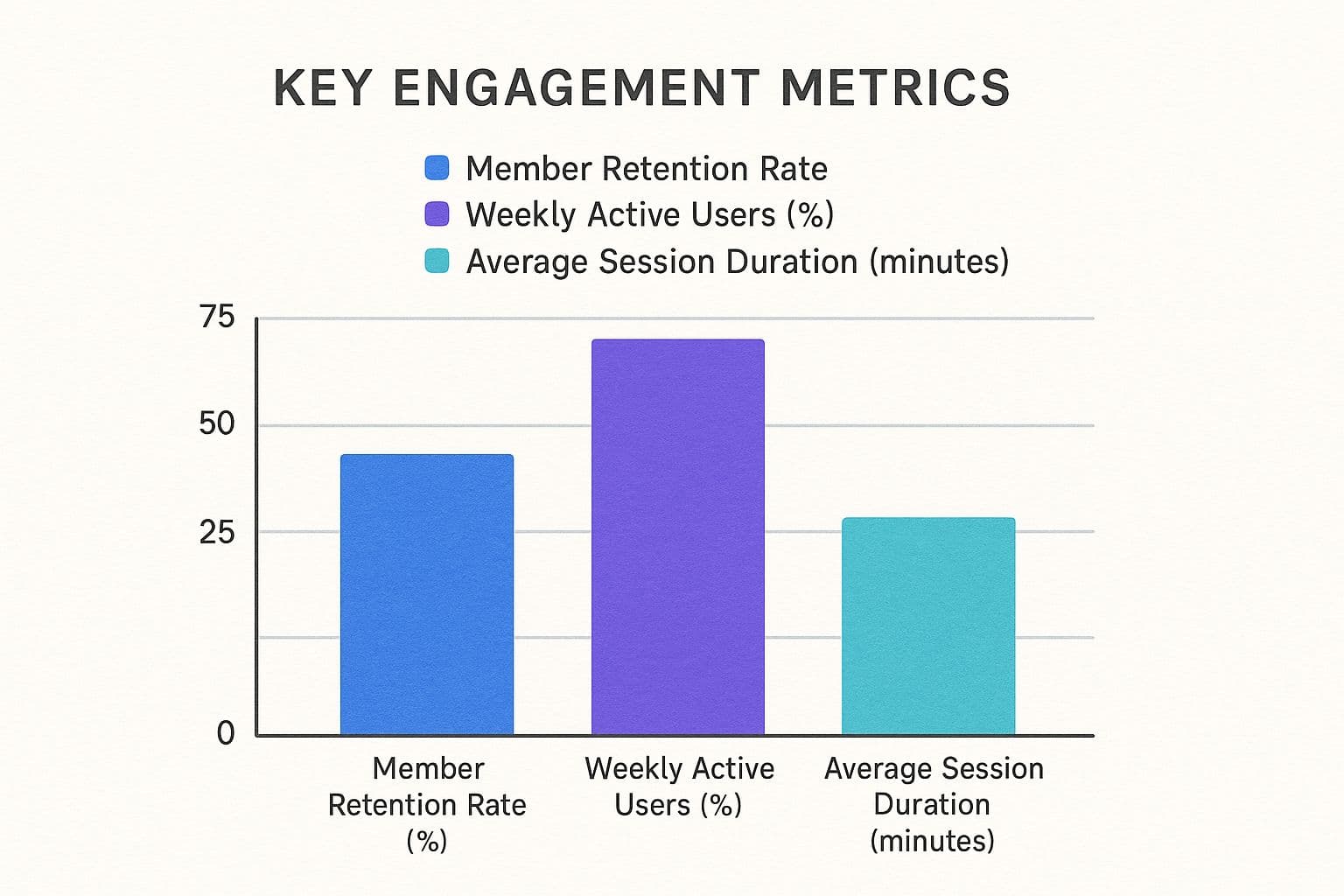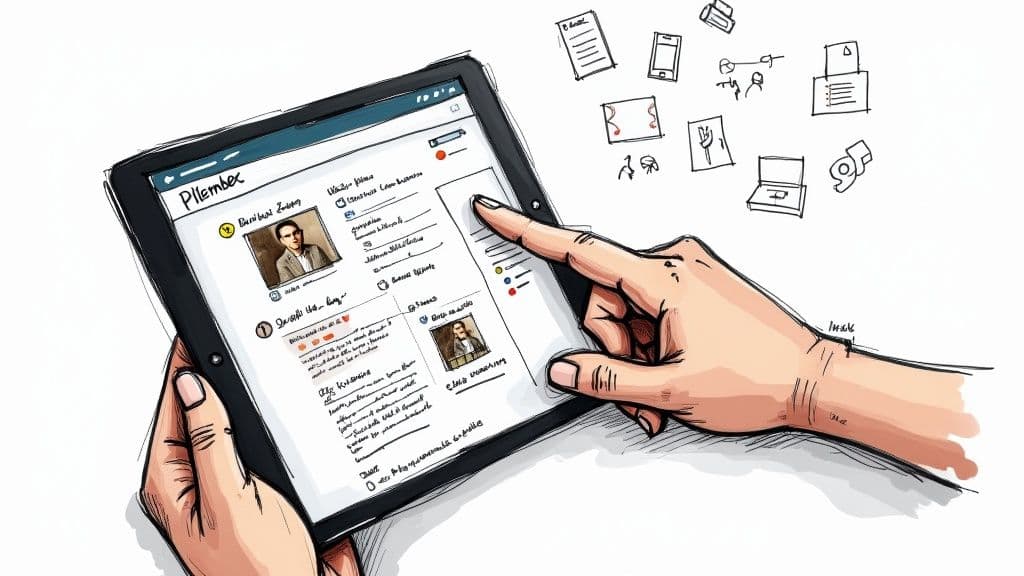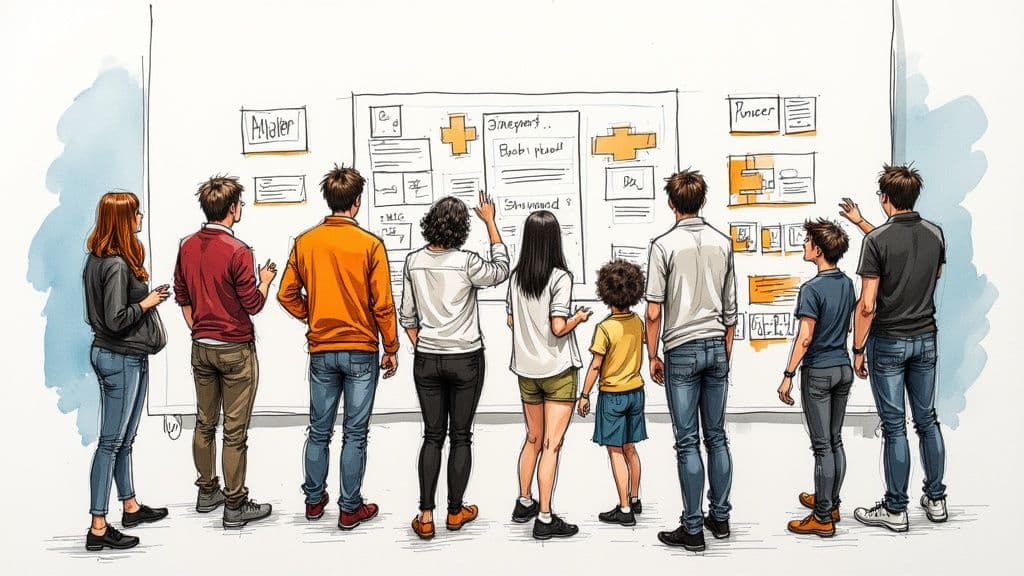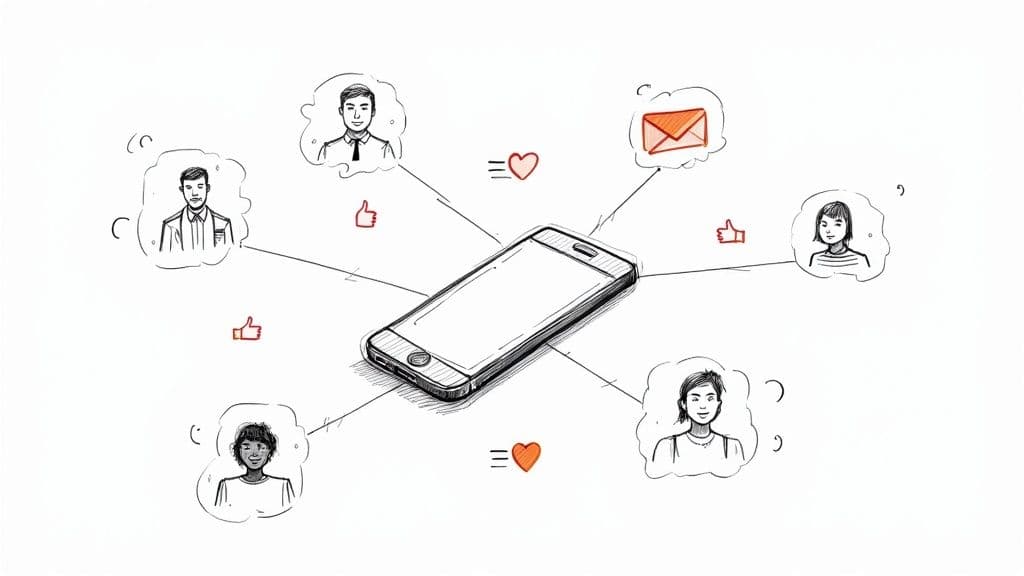Keeping your members hooked is less about just throwing content at them and more about crafting an experience they actually want to be a part of. I’ve found that the whole thing really boils down to three core ideas: giving people immediate value, helping them build genuine connections, and making them feel like they own a piece of the community.
When you get this right, people stop being passive lurkers and start becoming active, vocal fans.
Building Your Modern Member Engagement Framework
The old-school, top-down approach to community management is completely broken. Nobody wants to be in a group that just feels like another content feed. People expect to be part of something interactive, something that gives back. To keep members engaged today, you need a total mindset shift. Stop thinking of it as a checklist and start seeing it as an ongoing conversation.
That old model of just broadcasting information and praying for a reply? It’s dead. Engagement is a two-way street. It’s on you to create opportunities for members to jump in, connect with each other, and feel like they actually have a say in where the community is headed.
Understanding the Core Pillars
To build a community that lasts, you have to look past the vanity metrics. Forget just counting how many people are in the group. The real game is about the quality of interactions. That means you need to build an environment where joining in is both easy and genuinely rewarding.
The metrics that really matter paint a picture of a healthy, active community: think Member Retention, Weekly Active Users, and Average Session Duration.

042a93af-93ee-4e2a-8d36-747110490199.jpg
This stuff shows that a successful community isn't just big; it's alive. It’s valuable enough that people stick around for the long haul.
A huge part of this is delivering value in real time. For example, in the UK membership space, we're seeing a massive shift away from stale quarterly reports. Instead, smart communities are using instant rewards and shout-outs to keep loyalty high.
A truly engaged community feels alive because its members are empowered. When they feel seen, heard, and valued, they stop being just consumers of content. They become co-creators of the community’s culture and its success.
To really nail this modern approach, you have to get good at interactivity. If you're looking for inspiration, check out these 8 Examples of Interactivity to Boost User Engagement. They're full of powerful ideas.
Foundational Strategies for Engagement
Laying the groundwork really comes down to a few key strategies. These are the pillars that hold up any successful engagement plan, no matter how big your community is or what niche you’re in. They give you a clear path for turning passive members into your most active champions.
Here’s a breakdown of the core strategies that underpin a sustainable and active community. Think of these as the fundamental principles you need to build everything else upon.
Core Pillars of Sustainable Member Engagement
| Strategy Pillar | Core Principle | Example Tactic |
|---|---|---|
| Immediate Value | Members see a clear benefit from the moment they join. | A "new member quest" that guides them to key resources and rewards them upon completion. |
| Genuine Connection | Members are encouraged to build relationships with each other. | Facilitate member-led subgroups or host 'meet-and-greet' virtual events. |
| Community Ownership | Members feel a sense of influence and responsibility for the group. | Create a 'Community Champions' programme that empowers top contributors with moderation roles. |
Nailing these three areas is what separates a ghost town from a thriving, self-sustaining community where members feel invested and excited to participate.
Gamification: Turn New Members Into Superfans

7158258e-6351-4f8f-8655-f301feb633b5.jpg
Let’s be honest. Generic welcome messages and one-size-fits-all content are engagement killers. They scream "I don't know who you are, and I don't really care."
To make someone feel like they've landed in the right place, you need to get personal. Fast. And the smartest way to do that is by mixing personalisation with a little bit of gamification. This combo is how you turn a lurker into a lifer.
It all starts with watching what your members actually do. Are they clicking on certain types of content? Are they ignoring others? This isn’t about being creepy; it's about being observant. Use those insights to create a journey that feels like it was designed just for them.
This is especially critical because 41% of membership organisations in the UK admit they struggle with engagement. A tailored experience isn't just a nice-to-have anymore. It's how you win.
Your Secret Weapon: The "New Member Quest"
Instead of just dumping a new person into a chaotic feed and hoping they figure it out, give them a mission. I call it the 'new member quest'—a simple, rewarding series of tasks to get them familiar with your community's best bits.
This isn't about giving them homework. It’s about giving them a roadmap. This is a core part of the most successful member engagement strategies I've seen.
A simple quest could look like this:
- Step 1: Complete Your Profile. Easy first win.
- Step 2: Say Hello. Guide them to a specific introductions thread.
- Step 3: React to 3 Posts. Gets them exploring and interacting.
- Step 4: Ask One Question. The final boss of onboarding—sparking their first real conversation.
Once they complete the quest? Boom. Unlock a special badge or a flair next to their name. It’s a tiny reward, but it provides a powerful, immediate sense of accomplishment. You've just turned a boring chore into a game.
A well-designed gamified system doesn't just reward activity; it rewards the right kind of activity. It nudges members towards actions that build a stronger, more connected community for everyone involved.
Celebrate Wins Without Creating Losers
Leaderboards are a classic, but they can backfire. If you only celebrate the top 1% of power users, you're going to alienate the other 99% who feel like they can never catch up. That’s a fast track to a disengaged community.
The fix? Create multiple ways to win.
Don't just have a "Top Contributor" leaderboard. Add others, like "Most Helpful Newcomer" or "Best Discussion Starter of the Week." This lets you celebrate different kinds of value and gives everyone a shot at the spotlight. For a deeper dive on how this works in practice, check out these examples of gamified loyalty programs.
Ultimately, you’re building a sense of progression. When a member earns a badge for their first post, their 100th comment, or their one-year anniversary, they’re not just getting a digital sticker. They’re building a visible history within your community.
That history creates an investment. It’s their reputation, their status. And that deep-seated loyalty is incredibly hard to break.
Go Where Your Members Live: The Multi-Channel Play
Your Telegram group is your home base, your central hub. But if that's the only place the conversation is happening, you're leaving engagement on the table. To keep your community buzzing and top-of-mind, you have to meet people where they already are.
Think of it this way: your main group is the main stage, but the pre-show hype and the after-party chat happen all over the internet. A smart multi-channel strategy means you’re orchestrating that entire experience, using different platforms for what they do best, all while pulling people back to your core community.
Match the Vibe to the Channel
The biggest mistake people make? Cross-posting the exact same message everywhere. It’s lazy, and your audience can feel it.
Each platform has its own flavour, its own unwritten rules. A killer multi-channel approach plays to these strengths, creating a much richer experience for your members. It's not about being everywhere; it's about being in the right places with the right content.
A fitness coach I know crushes this. They use:
- Instagram Stories for raw, behind-the-scenes workout clips and quick Q&A sessions.
- Twitter (X) for rapid-fire polls like, "What muscle group are we smashing this week?"
- Exclusive monthly webinars on a dedicated platform for deep dives into nutrition and technique.
See how that works? Each piece of content is different, but they all funnel back to the value of the main Telegram community, where the real, detailed plans and support live.
A multi-channel strategy creates a seamless journey that always leads back to your core community. It turns your group from a single destination into a brand that members bump into throughout their day.
This isn't just a hunch. It's becoming critical for any community builder. A recent survey from Protech highlighted that association professionals in the UK now heavily rely on an active online presence to connect with their members. It’s no longer optional.
Go Deeper Than Just Text
Let's be real: text-based chats are great for daily check-ins and quick questions, but some interactions need a more personal touch. This is where live, interactive events come in. They're one of the most powerful ways to build real bonds and make members feel seen.
Virtual meet-ups or exclusive webinars create a sense of occasion that a simple post just can't match. Seeing faces and hearing voices? That’s what turns digital strangers into actual friends. It builds the kind of connection that makes people stick around.
Using other platforms like social media can also massively expand your reach. If you're looking for fresh ideas, these 11 effective social media strategies to grow engagement are a great starting point.
By spreading your community's presence across a few key channels, you’re building layers of value. You're not just running a group; you're building a vibrant world that your members are genuinely excited to be part of. That's how you create an engagement ecosystem that actually lasts.
Igniting Conversations and Building a True Community

f89599fc-19ec-4aaa-a918-0dbab897eb2a.jpg
Let's be real. A silent community is a dying community. If you’re the only one talking, you don’t have a community—you have a broadcast channel.
The real secret to keeping members engaged is to stop being the star of the show and start being the director. Your job is to create scenes where other people get to shine.
Forget the tired, generic “ask a question” posts that get three likes and a one-word reply. To spark real, meaningful discussion, you need to engineer moments of connection. This has less to do with the content you post and more to do with creating a shared experience.
From Passivity to Participation
First things first, you need to give people a reason to talk. The best way I've found to do this is by creating specific, recurring "event-style" posts that members can actually look forward to. These structured formats give everyone a clear reason and a safe space to contribute, removing the awkward guesswork of how to participate.
Here are a few battle-tested ideas you can steal:
- Member Spotlight Weeks: Pick a member and make them the star for a week. Share their story, celebrate a recent win, and encourage everyone else to ask them questions. It makes that person feel incredibly valued and gives the rest of the group a human story to connect with.
- Themed Debate Days: Choose a friendly, low-stakes topic relevant to your niche and split the group into two sides. For a fitness community, it could be something like “Cardio vs. Weights for fat loss.” This kind of structured conflict gets people talking passionately without it turning toxic.
- AMA Sessions: Host "Ask Me Anything" sessions with industry experts or even just with yourself. This provides a massive amount of value and instantly positions your community as the place to get credible info.
These structured events are the bedrock of a healthy group. For a deeper dive into the principles behind this stuff, our guide on building an online community breaks down more of these essential frameworks.
A community thrives when its members feel like they are contributing to something larger than themselves. Your role is to create the opportunities for that contribution to happen organically and consistently.
Empower Your Natural Champions
In every group, you'll start to notice a small handful of members who are naturally more active. They're the first to reply, the ones who jump in to answer questions for others, and the people who just get the vibe you're trying to build.
These are your natural champions, and they are your single most valuable asset.
Don't just let them burn out. You need to actively empower them. Reach out to them personally, thank them for their contributions, and give them a little bit of authority—a "Community Champion" or "Volunteer Mod" title goes a long way. That recognition alone is often enough to motivate them to do even more.
Finally, none of this works without effective moderation. This isn't about silencing people you disagree with; it's about protecting the space from genuine toxicity and spam. Set clear rules and, more importantly, enforce them consistently. A safe environment is an absolute prerequisite for open conversation, ensuring your group remains a place people actually want to be.
Using Analytics to Drive Smarter Engagement
Stop guessing what keeps your members around. Seriously. Relying on gut feelings is a fast track to a silent community and total burnout.
The secret to keeping a community buzzing isn't magic; it's data. You need to dive into your analytics and let the numbers show you what your members actually want.
Most community managers get obsessed with vanity metrics. Total member count is the big one. Sure, a group with 10,000 members sounds impressive, but it means nothing if only 50 people are active.
A group of 500 where half the members are chatting every day? That's infinitely more valuable. That's a real community.
Look Beyond the Surface
To get a real sense of your community's health, you need to track the metrics that reflect genuine activity. These numbers are the vital signs, the true pulse of your group.
Here are the ones that actually matter:
- Daily Active Users (DAU): This is your most honest metric. It’s the number of unique members showing up and participating each day. If your DAU is steady or climbing, you’re building a habit. That’s gold.
- Post-to-Comment Ratio: Are your posts sparking conversations, or are they just sitting there? A high number of comments per post means your content is hitting the mark and getting people talking, which is the whole point.
- Member Sentiment: What’s the vibe? Are people generally positive and supportive, or is the chat full of complaints and negativity? You can gauge this just by paying attention, but some tools can help track it more formally.
For anyone serious about building a lasting community, it's worth taking a deeper dive into the full range of community engagement metrics that can shape your strategy. Understanding these numbers is the first step to making smarter, data-driven decisions.
Turning Data into Action
This is where analytics becomes your superpower. It’s not just about looking at charts; it’s about spotting trends and acting on them.
For example, using Telegram’s own analytics or a simple bot, you might see a sharp activity drop from a member who used to post daily. That’s not just a random blip. It's a signal.
This is a member at risk of churning. Don't just let them fade away.
The best engagement strategies are proactive, not reactive. Use your analytics to spot at-risk members before they go silent for good. This gives you a crucial window to bring them back into the fold.
When you see that dip in activity, it's time to send a targeted re-engagement message. This isn't about spamming them with a generic, "Hey, we miss you!" message that everyone ignores.
It’s about sending a personal, value-driven nudge that shows you’re paying attention.
For instance, a quick DM could look like this: "Hey [Name], I noticed you haven’t been around as much lately. We’re doing a live Q&A on [topic you know they love] this Thursday and I immediately thought of you. Hope to see you there!"
This approach does three things brilliantly: it shows you notice them, it respects their specific interests, and it gives them a simple, low-effort way to jump back in.
By using data to guide these small, personal interventions, you can systematically boost retention and keep your community thriving. This is how you keep members engaged for the long haul.
Answering Your Top Community Engagement Questions

95d4f26b-30d9-4ae1-9c77-a5bfaa79c4d9.jpg
Even with the best game plan, you're going to run into the same old headaches as every other community manager. It happens. So, let's get straight into the big questions I hear all the time and give you some real, practical answers you can use today.
How Do I Re-Engage Inactive Members?
First, stop sending those generic, "We miss you!" broadcasts. They feel like spam because they are spam, and everyone just ignores them. The real key here is to get personal and offer actual value.
Dig into your analytics, find a member who’s gone quiet, and see what topics they used to get fired up about. Then, shoot them a direct message. Something simple like, "Hey [Name], we're running a Q&A on [topic they love] next week and your name came to mind," works wonders. It proves you're actually paying attention and gives them a specific, low-effort reason to pop back in.
Remember, the goal is to restart a conversation, not just tick a box on your to-do list.
Another tactic that works surprisingly well? Offer a grace period on a late payment. Giving people one last chance to see the valuable stuff they're about to lose is often the nudge they need to renew their subscription and jump straight back into the action.
What Is the Ideal Posting Frequency?
This is the million-pound question, right? The honest answer is: it depends entirely on your community's "metabolism." A high-octane group of day traders might crave multiple updates an hour. A community for a relaxed hobby like watercolour painting? They'd probably find that completely overwhelming.
As a starting point, aim for one high-quality, conversation-starting post per day. Then, you need to watch your engagement like a hawk.
- If the chat is flying and your posts are getting buried in minutes, you have my permission to post more. The group can handle it.
- If your posts are met with deafening silence, dial it back. You're likely causing content fatigue.
It’s far better to drop three incredible pieces of content a week that spark killer discussions than it is to post three times a day to a ghost town. Quality always, always trumps quantity.
Listen to the rhythm of your group. The data doesn't lie. It will tell you when to hit the accelerator and when to ease off.
How Can I Measure Community Engagement ROI?
Measuring the ROI of community can feel a bit like trying to bottle lightning, but it's absolutely essential for proving your worth. The trick is to connect your engagement efforts directly to real business goals.
Start with the metrics that have a clear financial link. For a paid Telegram group, the two big ones are Member Lifetime Value (LTV) and Churn Rate. It's simple: a highly engaged member is way less likely to hit the cancel button.
If you can prove that members who join your weekly Q&As have a 20% higher LTV than those who don't, you’ve just demonstrated clear, undeniable ROI.
Don't forget to track how your community impacts recruitment, either. A lively, active group is a testimonial machine that generates powerful word-of-mouth referrals. Make it a habit to survey new members and ask them why they joined. When they start saying, "I saw the awesome discussions happening inside," you've just drawn a straight line from engagement to new revenue.
Ready to turn your Telegram community into a thriving, profitable business without the administrative headache? MyMembers provides the tools you need to automate payments, manage members, and analyse your revenue, so you can focus on what you do best—keeping your members engaged. Transform your Telegram group today.
